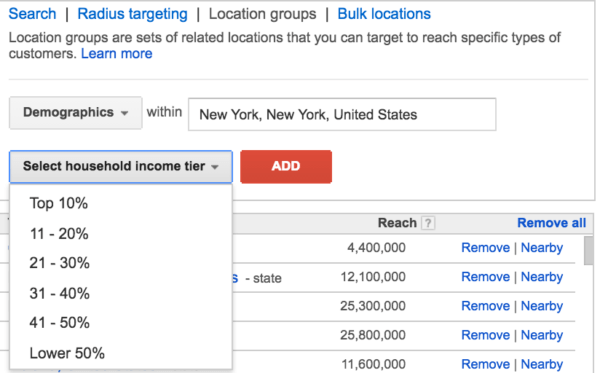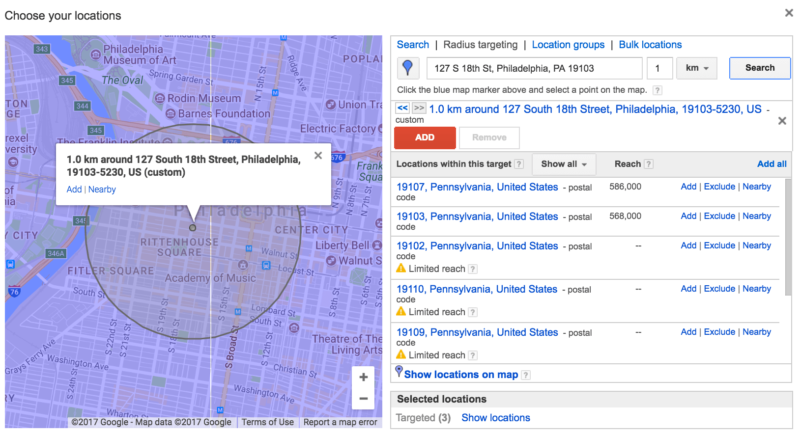Your 6 new ways to use location targeting
Looking to take your location targeting to the next level? Columnist Carrie Albright offers some new geotargeting ideas for your PPC campaigns.
As advertising platforms diversify the targeting options they provide, we are challenged to become more and more creative with exactly how we find and appeal to our customer bases.
Years ago, simply targeting the geographic region of interest was an easy win for improved relevance and reach. But times have changed, and so have the stakes.
Although location/geographic targeting is particularly advantageous to those with storefronts, there are improved tactics that impact those of us advertising goods and services that aren’t in a traditional retail space. Provided below are six new approaches to geographic targeting to boost your digital marketing strategies.
For those with brick-and-mortar operations, it’s presumed that you target a healthy radius around your stores. This should be square one.
For any moderate or advanced advertiser, it’s also expected that you target your high-performing geographic areas with location-specific campaigns or layered geo bids. But there is more that can be done to emphasize your presence to the existing or prospective customer base.
1. National vs. hyper-targeted campaigns
One example of hyper-targeted campaigns is a car rental company. It is assumed that if you offer services in Denver, Colorado, you will be targeting this region. It is also very likely that you have entire campaigns dedicated to rental car interest strictly in the Denver area.
But your next step should include all those outside of Denver with an interest in car rentals. This is the “embedded negative” equivalent of geotargeting in which all of the US is targeted, but Denver itself is excluded.
The theory:
The expectation here is that your service may be something a traveler is planning to need, even though they’re not in the area at the time. This segmentation allows you to offer customized pricing and location in your ad copy, and even send them to highly relevant landing pages.
The build:
- Example Campaign 1: Denver — Car Rental Interest
- Example Campaign 2: National — Denver Car Rental Interest
The major note to be made is that your new National campaign must contain a qualifier for Denver, so that you’re not wasting your budget on interest in an area you can’t accommodate.
- Example Denver campaign — Car Rental Interest Keyword: +car +rental
- Example National campaign — Denver Car Rental Interest Keyword: +car +rental +Denver +area
The evidence:
This approach was applied to an account that targeted certain city hubs across the US. From the data collected, we saw that volume was lower for the National campaigns, largely due to conservative budget usage, but that engagement was actually quite a bit higher.
This effectively improved our reach to those outside our target markets, while still generating a relatively similar ROAS, despite the slightly lower conversion rate.
2. Average household income
Google offers household income (HHI) targeting, which allows you to layer bids on or solely target areas based on their presumed average HHI. There are pros and cons to relying too heavily on what’s implied here, such as “My customer base skews to high economic status, so I should strictly focus on upper 20 percent.”
Instead of making assumptions and applying these levels at your own discretion, allow the data to tell you what to do. The benefit of this targeting type is that lead gen, e-comm, B2Bs and many more business models can benefit equally from this approach.
The theory:
Income targeting is yet another segment that can be used to push for improved reach or to reduce inefficiencies. Like any segment, be sure to revisit these optimizations regularly and reintroduce removed audiences every year or so to ensure traffic hasn’t changed so drastically that you’re now missing your customer opportunities.
The build:
Using the AdWords location targeting of “location groups,” apply all average income levels to your campaigns at a 0% bid adjustment:
Once you’ve created these targets, allow the data to populate in your campaigns:
As you gain confidence in the volume of traffic coming through these target levels, you may choose to optimize towards or away from a specific income level. You may even choose to exclude one group entirely or create a separate campaign for that level.
The evidence:
In the test below, we used income-level targeting, state-level locations and also ZIP codes for one specific state of interest. The results contain over 15,000 impressions (with an equal split between income and state audiences) across all types, with a strong CTR for income- and state-level targeting.
The more interesting aspect of this is the heightened conversion rate for those in the income-level target. From here, our next step is identifying whether to lean most heavily on the top-performing income brackets in the existing campaign or to break them out entirely to ensure it never wants for budget.
3. Target competitors
For those with a prominent competitor marketplace, it’s a strong prospecting strategy to keep in front of those customers who are considering your competitors. This requires that you know who your biggest competitors are and where they are located.
The theory:
These campaigns are appealing to new users who are demonstrating an interest in your product or service, and who are in the vicinity of a competitor who may cause you to miss that sale.
According to a study by DMI, 80 percent of shoppers used a mobile phone inside of a physical store to either look up product reviews, compare prices or find alternative store locations. As you build your own strategy for competitor locations, you are seeking to fulfill the latter two searches.
The build:
By placing a radius targeting on your competitor’s addresses, you stand a much better chance of appearing to them when they’re particularly low in your search funnel.
Focus this campaign’s keywords around your most successful non-branded terms and utilize promotion or price-competitive copy as you’re able. For those with online coupons, this audience is precisely the one to appeal to.
4. High-competition cities and regions
If the previous approach feels too aggressive, consider this alternative: Focus a portion of your targeting on cities or regions where competitors reside and include top non-branded terms as well as your branded terms.
The theory:
This approach may appeal to:
- those customers who have brand awareness of your competitors (and not you);
- customers who know you, but are inundated with competitor awareness; and/or
- customers who are searching for products/services you offer, but due to the competitor’s close range, may just as easily turn to them instead of you.
The build:
You may have your own market research on where competition is the highest. In that case, skew toward what those numbers are telling you, as they likely incorporate more channels than just paid search. However, if you’re not conducting these kinds of analyses, and you have campaigns broken into geographic targets, such as the New York search campaign below, there’s hope.
By pulling auction insights reports, you’re able to see which competitors are potentially stealing your customers in a particular region. This will allow you to prioritize where to push for more branded and non-branded coverage.
5. Target complementary behavior
There can be more to your geographic targeting than just finding your customers and selling them your goods and services. Part of a growing business’s strategy should revolve around incorporating your product/service into a bigger view. This means using behavior (or more so, location) to find complementary offers.
The theory:
Your potential customer does not operate in a vacuum. When they go grab coffee in the morning, it’s entirely possible they also want to grab a morning snack. When someone is shopping for birthday balloons and a helium tank, it is quite likely they may also need party plates, napkins and even a piñata. Thinking through how your product or service can be complemented by another can offer a new approach on location targeting.
The build:
If your service is a plumbing and electric company, it is entirely possible that visitors of home improvement stores may be in need of your assistance. In a campaign targeting “shower base installation,” you have the opportunity to not only target regions near your businesses, but also stores where these materials are being purchased.
By applying a radius target to these stores and focusing on specific services that your business provides, you are able to appeal to a highly relevant and potentially low-funnel customer.
6. Retargeting to the max
The final and arguably easiest strategy for utilizing geotargets is to apply audience lists to the preceding tactics. By adding retargeting lists to any of these, particularly competitor locations and complementary behavior targets, you stand to not only re-engage past visitors, but also reduce CPAs and improve conversion rates.
The theory:
In the example of competitor radius targeting: When better to remind your users that you’re alive and well and ready to provide the service you know they’re interested in than when they’re considering another?
The previous five strategies can all support your branding and prospecting initiatives, but for past visitors to your site, the investment is that much more assured: They’ve seen your site and potentially considered your product or service.
As their behavior indicates continued, renewed or complementary interest in your offerings, this additional layer can be the last piece of the puzzle to drive conversion.
The build:
By layering on remarketing audiences to these strategies, you can begin to see the data populate in your various past visitor groups. Once you see where top performance lies, it may behoove you to add bid modifiers to amplify or deter traffic from these lists.
And lastly, the targets and performance may dictate that an entirely new campaign is warranted to best provide messaging, bidding and budgeting to these users.
Final thoughts
Geo-targeting is an integral part of any marketing strategy, but taking your location targeted to a more in-depth degree can allow you to approach new (and returning) customers in a whole new way.
Opinions expressed in this article are those of the guest author and not necessarily Search Engine Land. Staff authors are listed here.
Related stories
New on Search Engine Land






